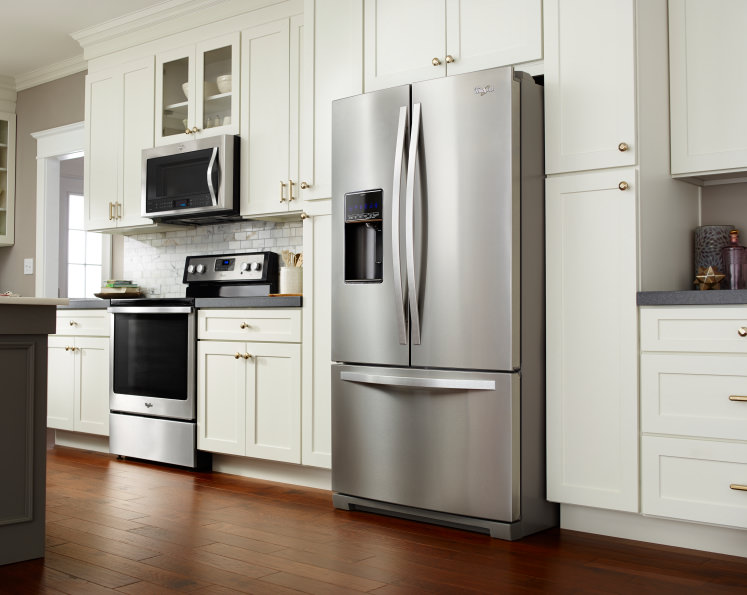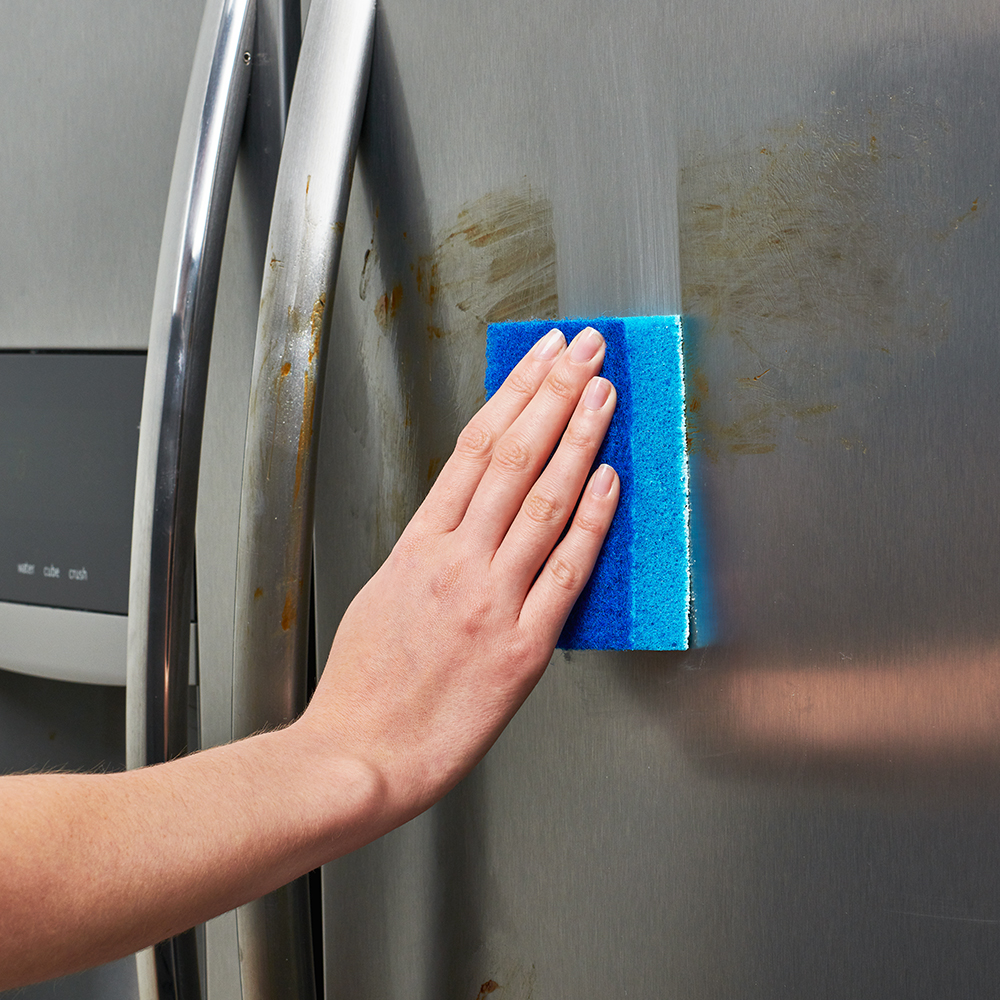Stainless Steel Appliances: A Dying Trend?
Did you know that stainless steel turned 100 years old in 2013?
Be it updated mid century homes or new-builds, kitchens today love a little (or a lot) of metallic shine. The so-called merits of the finish - easy maintenance, durability, stylishness - can be debated. Yet stainless steel mania appears to be the real deal - especially when you consider that almost 70% of US homeowners have stainless steel appliances in their kitchens.
But before we consider the benefits of stainless steel appliances, let's go back to the beginning for a moment - to where stainless steel all began.
Although there have been many prior attempts, it was Harry Brearley of Sheffield, U.K. who discovered 'rustless' steel - the first true stainless steel - in 1913. Although there had been many prior attempts, Brearley has been credited with inventing the first true stainless steel - by adding 12.8 % chromium to molten iron to produce a metal that not only did not rust, but was resistant to corrosion. Interestingly, Brearley stumbled upon this by accident, while he was studying the erosion of the internal surfaces of gun barrels for the British army during the onset of the First World War.
After Brearley's discovery, further improvements to stainless steel occurred at a fairly rapid pace, where it became a hot commodity in a wide variety of industries; It was used in the manufacture of kitchen sinks, trains, aircraft, underwater tv cameras and even the longest movable flood barrier.
Indeed, stainless steel is an incredibly useful material in the foodservice industry due to its strength, durability, and corrosion resistance. Among food grade stainless steel there are up to 150 varieties, and each of them have different properties. For example, 304 stainless steel is the most common type used in the kitchen. It has a bright shine due to a high level of chromium and nickel. It's also very resistant to corrosion and rust, although it's susceptible to corrosion caused by exposure to salt. It is commonly used for kitchen appliances. 316 stainless steel on the other hand is the second most common type of stainless steel, and its alloy includes an additional element, molybdenum, which increases its resistance to corrosion caused by salt and other chemicals. This type of stainless steel is best for kitchen equipment, hibachi grills, high-end cookware, equipment and furniture used outdoors, outdoor equipment used near the ocean
The golden era of stainless steel appliances in residential kitchens could be said to have begun in the early 2000s. When the new millennium hit, with all its concerns about Y2K, global popular trends reflected the sense that we had stepped into the future.

They were often found in stadium kitchens (kitchens that look like they could belong on a television cooking show) which were often found in McMansions. From ovens and refrigerators to microwaves and freezers, these professional-grade stainless steel appliances were mainly just for show.
At the time, the internet was still fairly young, but the rapid advancements in technology that it provided showed promise for the future. In fashion, a techno-utopian look with metallics and geometric shapes dominated trends. Sleek metallic stainless steel appliances extended that trend into kitchen decor.
Nowadays, there are alternatives to stainless steel, but whether they are more popular is debatable. Most major manufacturers have been trying out many different metals over the last 5 years, trying to be the first to find that "next big thing". Think of Jen-air "oiled bronze", Whirlpool's "sunset bronze", Miele's "truffle brown", or Viking's "graphite". There has even been a spike in the popularity of bold colors in the kitchen, due in part to a rise in the influence of European design trends within the U.S. market," according to Valentina Bertazzoni, head of brand and style at Bertazzoni. In the right kitchen, all of these finishes will look great. But none have really taken off like stainless steel... yet.
Despite the new trending alternatives, stainless steel is still a strong contender for the most popular kitchen appliance finish. Yet there are things to consider if you're thinking of converting. Here are some of the most common pros and cons that can come with stainless steel appliances.
CONS
Smudges Easily It's well-known that there is more fingerprint evidence on stainless steel appliances than there is in a CSI episode! On top of that, these appliances show every bit of smudge and grime. If you have children, you'll need to clean many times a day! Luckily, there are ways to ward off these prints, which I will touch on shortly.

Expensive Experts say you should plan to stretch the budget if you're going against white or black appliances, as stainless is often the most expensive option. The cost of stainless steel appliances has come down though as more manufacturers have offered these appliances, but you can still expect to pay a bit more for stainless steel than for a similar appliance made of enamel-covered steel. There's no one price, however, for stainless steel appliances, and the actual cost depends on the brand, the features, the unit's size and even where you live. Currently black stainless steel is currently the most expensive type of appliance, and while it is smudge and fingerprint-proof, is not a recommended finish to choose if you have small children or are in the kitchen a lot, as it is known to scratch very easily.
Non-Magnetic Depending on the combination of metals used to make a stainless steel appliance, a magnet may not stick to it. For instance, 430 stainless steel contains a very low amount of nickel, which makes it more magnetic. So If you don't have this type on your refrigerator doors, you won't be able to display photographs, artwork and reminders on the front of your refrigerator. Magnetic boards and re-usable putty would solve this issue though.
Not Eco-Friendly While stainless steel is commonly touted as 100% recyclable and eco friendly, the actual process of creating it may not be as such. Stainless steel is an iron alloy with added elements such as chromium, nickel, silicon, manganese, nitrogen and carbon. These raw materials are mined in different ways, and then melted together in electric arc furnaces. It can take 8 to 12 hours of intense heat until the metal becomes molten. And of course, Not all these mining practices are good for the environment, depending on the jurisdiction and type of mining. Moreover, while a stainless steel appliance may have an eco-friendly label on it, its components may have been mined in jurisdictions without environmental restrictions in place, such as areas in South Africa where Chromium is mined the most. (Chromium is an essential component of stainless steel).

PROS
Non-Porous There is a reason why stainless steel is most commonly used in commercial kitchens, hospitals and food processing plants: because it is easy to clean and nonporous, meaning it cannot absorb moisture or allow bacteria to form in crevices, like other materials such as wood.
Highly Durable Chromium is the alloying agent that gives stainless steel its corrosion resistant abilities. Some stainless steel types are more durable to corrosion than others depending on the content of chromium and other elements. It even fights off rust, fire and heat - which makes it top-choice for those who want an appliance that will last and not show wear and tear.
Stylish and Adaptable Looking pretty spectacular, stainless steel is the go-to option if you want your kitchen to look modern, sleek and trendy. There's a reason it's still the top choice of many kitchen designers. Though stainless steel appliances do give off a more industrial look, their neutral tone complements most kitchen styles. Whether you have a smaller, more traditional kitchen with natural, wooden cabinets or a more modern design with marble countertops, stainless steel appliances work.
Sustainable Ultimately, the most environmentally friendly materials are corrosion resistant and durable, have high-recycled content and recapture rates, provide long service life and reduce resource use. Stainless steel provides all of these benefits. If the correct stainless steel is selected and properly maintained, it will last the life of the project.
Cleaning Stainless Steel There are some important things to keep in mind when it comes to cleaning stainless steel appliances. It's particularly best to avoid using steel wool or any other abrasive sponges or scrubber pads, chlorine-based cleaner or anything with chloride in it, as well as oven cleaners.
And while fingerprints are a commonly known issue with stainless steel, there solutions to this. Fingerprints can easily be removed with the right cleaners.

Aside from WD-40 and glass cleaner, here are a few natural cleaning methods to try below:
White Vinegar & Olive Oil
- Apply white vinegar directly to a microfiber cloth, or spray directly onto your surface.
- Let sit for just a moment, and then wipe clean in the direction of the grain.
- Apply the vinegar as many times as necessary to remove any grime.
- Dab a clean towel into some olive oil and polish the freshly-cleaned surface in the direction of the grain. If any extra olive oil residue remains, wipe away with a clean cloth.
This method works well because the vinegar gets rid of all the grime, while the olive oil gives it a fresh, shiny polish.
Club Soda
- Spray club soda directly onto appliances and then wipe in the direction of the grain. Wipe clean with a soft, microfiber cloth.
- Not only will this help clean the surface of fingerprints and food residue, it will also give it a nice shine.
Baking Soda
- Dampen a clean rag white distilled vinegar and wipe down the area
- Next, make a paste using baking soda and water.
- With a soft cloth, rub the baking soda paste onto the stainless steel.
- Let the solution rest for several minutes.
- Rub the paste off with a dry towel.
- Dampen another soft cloth with the lemon juice.
- Rub the fabric over the stainless steel ( helps reduce any limescale build-up).
- Rinse the area with water and wipe dry with a clean, dry towel.
The lemon juice is naturally acidic, and will thoroughly disinfect the area, while the baking soda is gentle and a natural deodorizer.
Unless you purchase a stainless steel appliance with a specific anti-fingerprint coating, there's no way to completely fingerprint-proof your stainless steel appliances. However, with regular cleaning you can stop the problem from getting out of hand, and some household supplies (such as oil) can even add a buffer layer between your appliances and your family's fingertips.
As you can see, stainless steel appliances have the potential to last for years, providing they are cleaned and maintained on a regular basis. And it is this high level of durability that makes them likely to remain high in popularity for many years to come.
Are you thinking about getting a stainless steel appliance? Serving Burnaby, Coquitlam and the Lower Mainland, ElectraFix is proud to offer you top brand name kitchen and home appliances such as: Whirlpool, Bosch, KitchenAid, Samsung, LG, JennAir, and many more. Contact us today for more information.